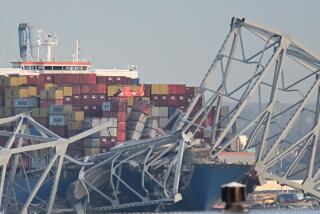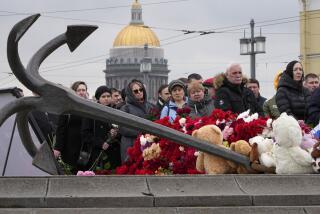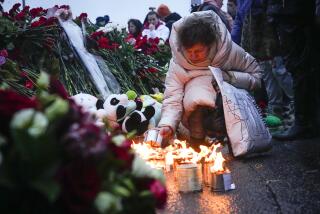Russian Roof Collapse Toll Rises
- Share via
MOSCOW — The toll from the Thursday morning collapse of a roof at a Moscow market rose relentlessly as rescuers dug through the rubble, with 57 confirmed dead by this morning, at least 31 injured and possibly dozens more still trapped.
Officials opened an investigation amid speculation that heavy snow might have contributed to the collapse.
Throughout the day, rescuers used sledgehammers, pickaxes and metal cutters to fight through the wreckage, avoiding the use of large equipment that might crush survivors. Some of those trapped used cellphones to direct rescuers to their location. At night, workers brought in heavy machinery to dig deeper through slabs of concrete, despite the risks. Rescue dogs helped in the search.
The collapse occurred about 6 a.m., shortly before the Bauman market was due to open to the public, so most victims were traders at the market or municipal workers. Many were from former Soviet states of Eastern Europe or Central Asia, regions that supply most of the workers for Moscow’s big markets.
Valery Mirzoyev, 34, a market worker, told how he spent the night at the market and was awakened by the collapse.
“I sat and kind of slept with my head on the fruit counter when something hit me on the neck between the shoulders,” Mirzoyev said. “I thought a trader threw some fruit at me to wake me up. I raised my head and heard some dull sound, a crunchy sound of concrete and cement breaking up. There was no explosion. I would have heard it. And then, as if in a dream, I saw the ceiling coming down right in the center of the market as if in slow motion.
“There was a lot of dust around,” he said. “Somebody was screaming in pain not far from me. Then I finally realized it was not a dream and I ran out.”
As night fell, relatives of those people believed still missing maintained vigils near the ruins of the Bauman market, which sold household goods, produce, meat and dairy products.
Mamed Aliyev, 40, an Azerbaijani businessman, said he was searching for his cousin, Makhit Dzhafarov, 24, who sold herbs at the market.
“I know that he is somewhere there under the ruins,” Aliyev said. “In the morning he called his friend on a cellphone from the market basement and said that he and other men were trapped there and that hot water from the broken central heating pipes was flooding the basement. Then his phone went dead.
“I hope he is still alive,” Aliyev added. “I went to two hospitals but he wasn’t there. I didn’t go to the morgues yet.”
Daliya Sibashvili, 50, was sitting Thursday evening at a psychological help center set up in an office building one block from the market, drinking hot, black tea from a plastic glass, holding a cellphone and dialing her husband’s cellphone.
“At first it was ringing but there was no answer. Now it is not ringing anymore,” she said through tears. “My friends are looking for him in hospitals and morgues. His name is not in any of the lists. If he is alive, why is he not calling me? If he is dead, I don’t know how our family will survive.”
The collapse came two years after the roof of a Moscow indoor water park called Transvaal Park caved in, killing 28 people. The building was designed by architect Nodar Kancheli, who also designed the Bauman market, built about 30 years ago.
Kancheli was charged last year with negligence over the design of the pool complex, but he has denied responsibility. He visited the market Thursday and was later questioned by investigators, the Russian news agency RIA Novosti reported.
“I think one possibility is a big buildup of snow,” Kancheli told Echo of Moscow radio. “And they set up kiosks on the mezzanine, which was not originally planned.” Corrosion may have played a role, he said.
About 3 inches of snow had fallen in the city overnight, adding to a considerable amount already on the ground. Moscow has had a particularly cold and snowy winter.
Heavy snow loads were blamed earlier this winter for fatal roof collapses at an exhibition hall in Katowice, Poland, and an ice rink in Bad Reichenhall, Germany. A total of 81 people were killed in those incidents.
Many Moscow buildings have snow removed from their roofs by workers periodically throughout the winter. But Moscow Mayor Yuri M. Luzhkov said the Bauman market’s roof was designed to have the snow melt and drain away “so there was no special need to have the roof cleared of snow.”
“We can safely say that the collapse of the market’s roof is not a terrorist act,” Luzhkov told reporters.
Prosecutors opened a criminal investigation of suspected negligence leading to deaths, RIA Novosti reported. President Vladimir V. Putin called for a “painstaking investigation.”
Sibashvili, a native of Georgia, said she had worried about the safety of the market’s roof.
“Back home in Georgia people who live in the mountains sometimes can get killed by a snowslide,” Sibashvili said. “But here in Moscow I could never believe the snow can kill you until ... Transvaal Park collapsed. I recall I was watching on television then and I thought: ‘Our market can also collapse like this. It is just a huge dish which hangs out there and can fall on our heads anytime.’
“And it did,” she added. “Why, why didn’t anybody learn a lesson when Transvaal fell? Why didn’t they remove the snow?”
Holley reported from Kiev, Ukraine, and Loiko from Moscow.
More to Read
Sign up for Essential California
The most important California stories and recommendations in your inbox every morning.
You may occasionally receive promotional content from the Los Angeles Times.










